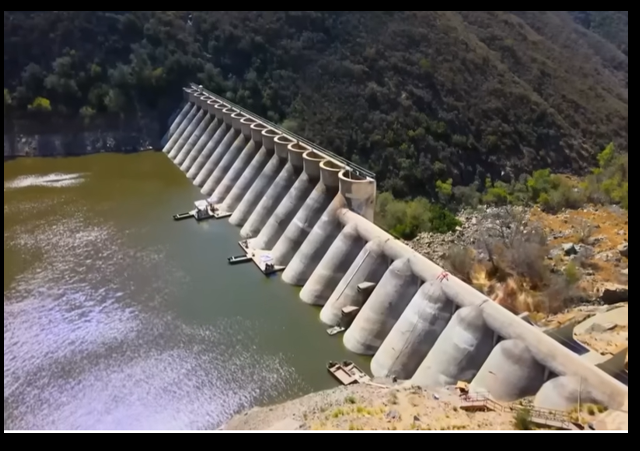San Diego Releases 600 Million Gallons From Lake Hodges Dam Due to Safety Concerns

In the golden days of California’s prosperity and responsible governance, our state built infrastructure that could last and power sources that could fuel innovation and growth.
Good times, my friend, good times.
I reported on the threatened breach of the Oroville Dam in California during a set of rains in 2017. I noted valuable lessons should have been learned as a consequence of the evacuation of the region near that dam.
Governor Jerry Brown was listening only to scientists who believed in man-made global warming, assumed that the drought would last forever, and wanted to divert resources to vanity projects and supporting illegal aliens.If Californians don’t want to relive this scenario, possibly with an actual catastrophic failure, then they should review their choices in 2018 and remake the political infrastructure.
No lessons have, in fact, been learned . . . as the residents of San Diego are discovering in 2024.
Over 600 million gallons of water has been released from a San Diego lake following atmospheric rivers that unleashed record rainfall on California in recent weeks.Lake Hodges, in San Diego, must be kept only 30 percent full at all times, due to safety concerns surrounding its dam. The dam is over a century old, and officials fear it may not be able to hold such a high amount of water. And when record rainstorms sweep across the state, officials release water to brace for a sudden influx of water….”Due to recent rainfall, the City of San Diego, the owner of Lake Hodges Dam and Reservoir, has been using Santa Fe Irrigation District facilities to release water from Lake Hodges,” the Santa Fe Irrigation District told CBS 8 in a statement. “The release began on January 24 and will continue for the foreseeable future… The Department of Safety of Dams requires the City to maintain a maximum capacity of 30 percent due to the dam’s condition.
There is a lot of finger-pointing going on between various government officials. However, no move is being made to address the issues raised by the fact the dam is now 100 years old.
City officials argue the dam needs to be replaced because it’s old. “Hodges Reservoir has been in our portfolio of reservoirs and dams for over 100 years it was actually constructed in 1918. So, it’s over 100 years old,” said Kleis.But if you speak with other district officials, who have water rights to Lake Hodges, they’ll tell you the city of San Diego did not maintain the dam properly for decades. “Had there been increased maintenance of the dam it would have extended the life of the dam,” said Seth Gates, an administrative director with the Santa Fe Irrigation District.Moreover, Gates said the state order to keep the water level low on Lake Hodges forces his district to purchase more expensive, imported water resulting higher water bills for customers. “There are customers that are seeing roughly a 35 percent increase in their bills,” Gates said during an interview in August.
Even if it started today, it would take a decade to build a new dam.
Meanwhile, on San Diego’s border with Mexico, there are other infrastructure challenges that are not being properly addressed.
A transboundary sewage stream that regularly flows from Tijuana, Mexico, into San Diego County may be creating a multifrontal public health crisis — as a noxious mix of chemicals and pathogens makes their way into households not just via water, but also through air and soil.The cross-border contamination — a result of inadequate infrastructure and urbanization — poses a persistent public health threat with significant socioeconomic and legal implications, according to a white paper shared with The Hill prior to its public release Tuesday.Of particular concern is the possibility of the reemergence of diseases that had previously been eradicated in California, microbes carrying antibiotic-resistant genes and industrial chemicals that have long been banned in the U.S., according to the authors.
The upside for me is that I will be closer to the infectious disease outbreak story than I was for covid. This is also the downside.
CLICK HERE FOR FULL VERSION OF THIS STORY